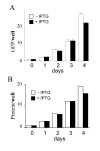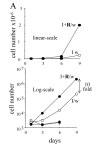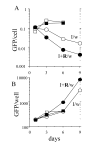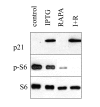Quantifying pharmacologic suppression of cellular senescence: prevention of cellular hypertrophy versus preservation of proliferative potential
- PMID: 20157583
- PMCID: PMC2815749
- DOI: 10.18632/aging.100115
Quantifying pharmacologic suppression of cellular senescence: prevention of cellular hypertrophy versus preservation of proliferative potential
Abstract
Development of agents that suppress aging (aging suppressants) requires quantification of cellular senescence. Cellular senescence in vitro is characterized by a large cell morphology and permanent loss of proliferative potential. When HT-1080 cells were arrested by p21, they continued to grow exponentially in size and became hypertrophic with a 15-fold increase in the protein content per cell. These changes were mirrored by accumulation of GFP (driven by CMV promoter) per cell, which also served as a marker of cellular hypertrophy. Preservation of proliferative potential (competence) was measured by an increase in live cell number, when p21 was switched off. While modestly decreasing hypertrophy in p21-arresrted cells, rapamycin considerably preserved competence, converting senescence into quiescence. Preservation of proliferative potential (competence) correlated with inhibition of S6 phosphorylation by rapamycin. When p21 was switched off, competent cells, by resuming proliferation, became progressively less hypertrophic. Preservation of proliferative potential is a sensitive and quantitative measure of suppression of mTOR-driven senescence.
Keywords: aging-suppression; cellular hypertrophy; cellular senescence; mTOR; rapamycin.
Conflict of interest statement
MVB is a founder of Oncotarget.
Figures












References
-
- Serrano M, Blasco MA. Putting the stress on senescence. Curr Opin Cell Biol. 2001;13:748–53. - PubMed
-
- Shay JW, Roninson IB. Hallmarks of senescence in carcinogenesis and cancer therapy. Oncogene. 2004;23:2919–2933. - PubMed
-
- Ruggero D, Montanaro L, Ma L, Xu W, Londei P, Cordon-Cardo C, Pandolfi PP. The translation factor eIF-4E promotes tumor formation and cooperates with c-Myc in lymphomagenesis. Nat Med. 2004;10:484–486. - PubMed
-
- Efeyan A, Ortega-Molina A, Velasco-Miguel S, Herranz D, Vassilev LT, Serrano M. Induction of p53-dependent senescence by the MDM2 antagonist nutlin-3a in mouse cells of fibroblast origin. Cancer Res. 2007;67:7350–7357. - PubMed
MeSH terms
Substances
LinkOut - more resources
Full Text Sources
Other Literature Sources
Medical
Miscellaneous
